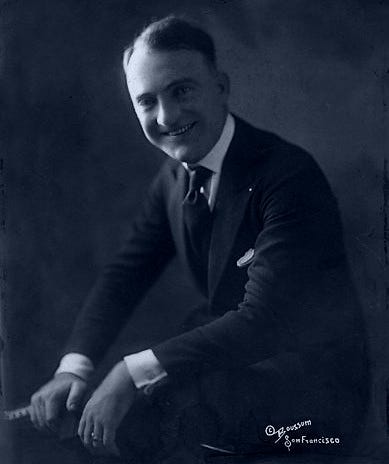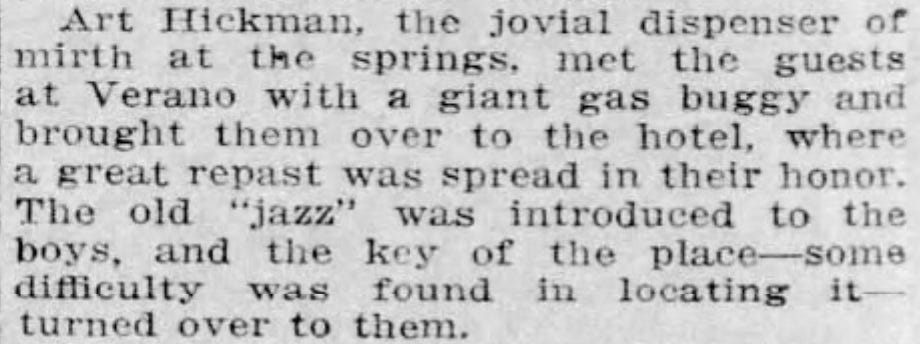In our first two explorations of the word “jazz” (see the Index) we’ve learned that it developed from “jasm” aka “jazzum,” that it was first used among baseball players in California, that it first appeared in print in 1912, that it had multiple meanings, many of which are still in use today, and more. But how did the word migrate from California to Chicago, and from sports to music? Well, Boyes Hot Springs (aka Boyes Springs), about 90 minutes north of San Francisco (aka S.F.), was a very popular summer resort, and was also a place where baseball teams went to train before the season. The Boyes Hot Springs Hotel offered entertainment in the evenings, and in the spring of 1913 it became a hub for baseball, music, and Chicago visitors—a “perfect storm” for the spread of the word “jazz.” Let’s begin to follow the story:
Boyes Springs was frequented by lots of folks from San Francisco and its news appeared in S.F. newspapers. So the San Francisco Examiner issue of February 19, 1913 reported that spring training for the San Francisco Seals would begin at Boyes Springs on Monday, February 24. And Art Hickman would arrive the same day to organize entertainment—a vaudeville show and silent films every night:
Arthur George “Art” Hickman was born June 13, 1886 in Oakland, across the bay from San Francisco. A drummer (and pianist), he was an enterprising young man and at the age of 19 he was already advertising regularly in the S.F. Examiner to find “cakewalkers” (cakewalk dancers) for the shows he produced at the Chutes Theatre (mentioned above), which was part of an amusement park complex. Here’s one classified ad from June 28, 1905, that he placed often:
“Of all nations” meant Black as well as white. Many vaudeville shows outside the South featured Black and white performers, performing separately. Vaudeville shows consisted of many short unrelated acts. Sometime after mid-1908, Hickman moved on to produce shows at the Princess Theater.
By April 30, 1911, the San Francisco Call noted that as audiences for vaudeville declined, Hickman had moved next door from the Princess to become manager of the Garrick, the largest movie theater in the city—and, with 1,600 seats, one of the largest in the country. (All of these theaters were in the Fillmore district, which had survived the earthquake of 1906.) Silent films were almost never screened without “live” music by a piano, small band or, in a theater of this size, sometimes a larger group, so he surely was involved in directing or organizing the music as well. The 1911 article included a drawing of Hickman—I’ve placed it alongside a 1920s publicity photo:


In June 1911, Hickman began his first season as entertainment director at the Boyes Springs:
This was in the Vallejo Evening News, June 15, 1911, p.2. Vallejo is about halfway between S.F. and Boyes Springs. Hickman was involved in various projects during 1912, including a project in Milwaukee early in the year, and producing a musical comedy and touring shows during March 1912. He was at Boyes in the summer of 1912 and was probably entertainment director there again. (I haven’t found confirmation of the director position for 1912, but it’s certainly likely that that is why he was there.) And on December 1, 1912, he briefly took over the Diepenbrock Theater in Sacramento until early January.
So, by February 24, 1913, when Hickman returned to Boyes Springs as the “Manager of Amusements,” he was already well known and well prepared. As part of his duties, he wrote a few articles for the newspapers about the events there, including baseball games. (But he was never a reporter, as I saw written on one website.) And he put together a band to accompany the vaudeville acts and the films. Wikipedia calls this a “sextet,” but sports writer Abe Kemp said that in 1913 it was a quintet including violinist Steve Douglas—in those days a violinist was considered essential for most dance music, white and Black. (Kemp, “33 Yrs. Later—Rain Again,” S.F. Examiner, February 28, 1946, p. 18.) While Kemp was not reliable on other matters, he might have been right about this, as Douglas worked with Hickman regularly through at least 1921. The group in 1913 also included drummer Charles Dowski, which suggests that Hickman was sometimes too busy directing to play drums himself. Reporter “Scoop” Gleeson in 1938 remembered a banjo player. And in March, Hickman advertised for a ragtime musician:
By May 1913, he had hired ragtime pianist and composer Leon Carroll from San Rafael. (During the 1914 session he was said to have worked there with “a couple” of musicians, and to have purchased an organ, perhaps for Carroll to play.)
Now, here’s where everything starts to come together:
Several papers reported that on March 24, 1913, the Chicago White Sox “Division two” team arrived to play against the Seals the next day. In other articles they are referred to as the White Sox “seconds” and as “second stringers.” Clearly, this was a group not made up of the top-rated players. The first “official” Boyes Springs game was on April 13 that year, and, from later articles, it is clear that this was an “exhibition game” against some of the lesser White Sox players, and would not count in the final season statistics.
The article about the White Sox visit, by sports writer Francis J. Mannix, used the word “jazz.” That’s no surprise, because the word had already appeared in that newspaper on March 3 and March 6 (that was the date that Gleeson explained the term—see previous essay), so it was clearly known to everyone there by now. (Peter Reitan, aka Peter Jensen Brown, mentions the significance of this visit, but does not refer to the item I’m about to show you.) Let’s read the most relevant excerpt (S.F. Bulletin, March 25, 1913, p.16):
Let’s talk through this significant little paragraph. Hickman met them in his giant car at El Verano. The Southern Pacific railway network had a stop there in those days, and it’s only about two miles from the Boyes Springs. At the end of the paragraph, we are told that there was some difficulty locating the key of the place. This is a joke around the idea of giving someone the honorary “key to the city.” It’s just a way of saying that they were treated like royalty.
And of course the phrase that stands out to us today is, “The old ‘jazz’ was introduced to the boys.” As I’ve explained elsewhere, “boys” was used in those days to refer to performers—even baseball players—both white and Black. But what does “jazz” mean here? It clearly does not refer to Hickman’s music, and the evidence indicates that the phrases “jazz music” and “jazz band” came later.
So what was the old “jazz”? Well, the word was already being used in many settings. David Wilton points out this article which appears in the 22 June 1913 issue of Minnesota’s Duluth News Tribune:
Take Frisco, the great slang factory of this broad land. Out there they ask you, “Are you jerry to the old jazz?” meaning thereby, “Are you hep to the—” whatever you are supposed to be hep to. “Jazz” stands for whatever you want it to.
("Hep" was already in wide use and has been dated to at least 1905.) In other words, the way “jazz” was used back then is a little like the way “jawn” is used in Philadelphia to this day. Or, similarly, it was something like the way a musician friend of mine sometimes uses the word “Jones” for everything, as in “Let’s go to the Jones and get some Jones.” The Hopkins article about the “futurist” word “jazz,” April 5, 1913, mentioned in the previous essay, says that it’s fun to use the new word any way you want to:
So—I think that in the White Sox case, the “old jazz” might have meant introducing them to “the scene,” or perhaps, more specifically, to the hot springs, and to the swimming pool or “tank,” as they called it.
So, here is the “perfect storm”: Baseball players from Chicago hanging out with, and playing against, the San Francisco team, in the presence of bandleader Hickman, and using the word “jazz.” That’s everything we need to explain the word’s migration to Chicago and later to music, all at the same time and place.
Hickman went on to a very successful career. The manager of the St. Francis Hotel in San Francisco heard his group at Boyes and hired them to play for dancing in the hotel’s Rose Room, for which Hickman wrote his most recorded song by far, “Rose Room” (with lyrics by Harry Williams), in 1917. Here you can listen to his 1919 version of it, featuring a piano solo by Frank Ellis, as well as three other Hickman recordings. He wrote or co-wrote a few dozen other songs and made about 100 recordings as drummer and leader, beginning with about 38 tracks while performing in N.Y.C. during 1919 and 1920. Hickman had influence in the early jazz dance band movement, and was about four years older than Paul Whiteman, whose music was somewhat similar. It is often claimed that Hickman’s was the first band to have a “sax section,” but he only used saxes playing together as a section starting in 1924, I believe, so I’m not sure this is true.
Hickman had a mixed relationship with the word “jazz.” He accepted it, but from a 1919 article it’s clear that, like most musicians Black and white, he felt that the word had been foisted onto him and that it wasn’t his choice:
(No author, “Dance Grows in ‘Dry’ Cafes”—a reference to Prohibition, which would begin on January 17—S.F. Examiner, October 12, 1919, p. 61) Those quotes also confirm that he still associated the word with its original meaning from his Boyes Springs days. Elsewhere he made it clear that he didn’t want to be associated with the kind of raucous music that most people associated with “jazz” back then. (For example, see “Art Hickman Defines Jazz,” The Talking Machine World, July 15, 1920, p. 6.)
In 1930, Hickman died in San Francisco of the rare Banti’s disease at age 43.
Still to come—my research on “Scoop” Gleeson’s claims about the word “jazz,” and Bert Kelly’s assertions that he named the first “jazz band,” and more!
All the best,
Lewis










These articles are some of the best things I have read on substack. Keep up the excellent work!
My lord, this surpasses your previous work on the topic, which was definitive. Thank you!